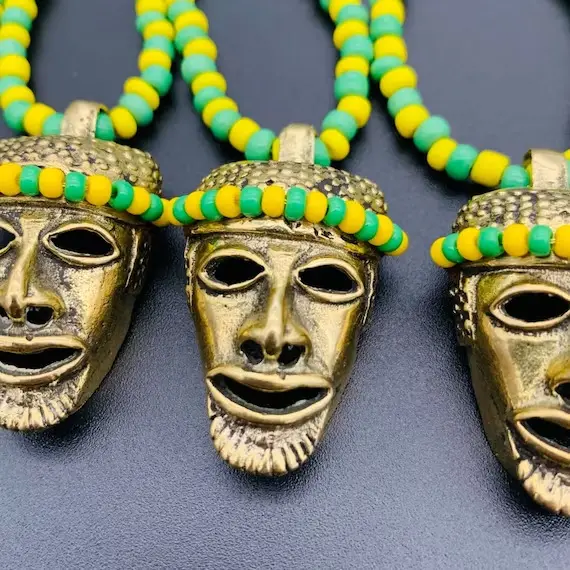Elekes stands for beaded necklaces donned by the Lukumi or Santeria Religion faithfuls.
The beads are usually 5, presenting supernatural entities called Oshun, Yemaya, Eshu, Chango, and Obatala.
The necklaces are issued to new believers in an initiation ritual led by a Santeria religious leader.
Being a consecrated necklace, it, therefore, matters when someone touches your Elekes without your permission.
So, which action should you take if someone touches your Elekes? Below is a list of ideas on how you should approach the situation:
1. Express your concern
It is essential to let the person know that touching your Elekes without your consent went against your beliefs.
If they are respectful, they will express remorse and understand your reaction.
2. Educate them
The person probably didn’t know the significance of the Elekes and thought it was just another decorative necklace.
Take the chance to explain to them the necklace’s spiritual role and why it should be respected.
Doing so will help them understand why they should not touch your Elekes again.
3. Find out their intentions
There is a chance the person didn’t touch your Elekes accidentally but purposefully did so.
If you determine they were aware of Elekes, find out why they intentionally touched them.
Whichever the reason they offer, opt to resolve the issue amicably and emphasize the spiritual need to maintain the necklace’s sacredness.
4. Consult your Padrino
If you cannot resolve the Elekes touching issue amicably, consult your religious leader on the next step.
Is it Bad Luck if Someone Touches My Elekes?
Elekes being a holy object, it may seem unpleasant when someone intentionally or ignorantly touches it without your consent.
You may fear that the person’s actions may bring bad luck or render your elekes unspiritual.
The good thing is that while touching someone else’s elekes is highly discouraged, it does not necessarily bring bad luck.
However, since Santeria’s beliefs may vary in different communities, it is critical to consult with your religious leader for an interpretation of what it means when someone touches your elekes.
They will advise you on whether it is harmless or if a re-cleansing should take place.
How do I Cleanse My Elekes if Someone Touches My Elekes?
If you are convinced that your elekes need to be cleansed after someone touched them, there are a few things you can do;
- Stir them in salty water: Salty water is widely known for its cleansing property and eliminating negative energies. In a bowl of salted water, stir your necklaces. Doing so will do away with unwanted spiritual forces.
Also Read: Putting Salt In Corners Of The House To Ward Off Negative Energy: Does it work?
- Expose elekes to the sun or moon: Exposing touched elekes in the sun or moonlight can help to cleanse them and restore their sanctity. The exposure helps restore the power of the necklaces when left under direct sunlight or moonlight for a few hours.
- Prayers: Praying for your elekes is another way to restore holiness. Say a prayer while holding the necklaces in your own words or those taught by your religion. Have faith that your prayer will help regain the necklace’s sacredness.
- Purify elekes using incense or smoke from consecrated herbs: Smoke from frankincense or sage can help sanctify your necklace once again.
- Talk to your religious leader: If not sure how to approach elekes spiritual cleansing, get in touch with your religious leader for a cleansing session.
Are There Any Rituals to Perform After Someone Touches My Elekes?
What happens after someone touches your elekes without your consent?
The Santeria religion proposes rituals to cleanse the elekes and the wearer to restore their spiritual connection.
These are the two rituals to expect following another person’s constant with your elekes:
I. A re-consecration ritual
A repeat of the consecration ritual to restore the necklace’s lost holiness.
The ritual seeks to reconnect the beaded necklace with the five spiritual entities in a religious ceremony involving prayers and offerings.
II. Personal purification
Besides the reconsecration of elekes, the wearer is also subjected to a cleansing ritual to eliminate unwanted spirits that may be released by the person who touched the elekes.
The practice involves Santeria prayers, chants, and bathing in water infused with holy herbs like rosemary and basil.
The spiritual procedure gets rid of all evil energies surrounding the elekes owner.
Can I Still Wear My Elekes After Someone Has Touched Them?
You may have conflicting thoughts on whether to continue wearing your elekes after someone touches them.
The decision to continue or discontinue wearing them lies within your Santeria traditional beliefs because they vary in different communities.
Your religious leader can expound on the matter for clarification.
Some continue wearing their touched elekes, but only after reconsecration and purification.
You can comfortably continue donning your sanctified necklaces as long as a reconnection has been established between you, the five Orishas, and the elekes.
Also check:



